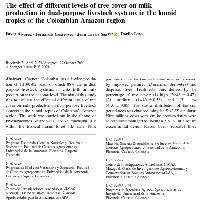Resumen
- Caquetá, Colombia, has a bovine population of 1,809,702 head, of which 88% are in dual purpose livestock systems; it ranks fifth in milk production at the national level. The aim of this study was to evaluate the effect of different levels of tree cover on milk production in dual-purpose livestock systems in the humid tropics of Colombia's Amazon region. The work was carried out in the Centro de Investigaciones Amazonicas CIMAZ Macagual. It is within the tropical humid forest life zone. Nine pastures of one hectare each were selected, covered by improved pastures (Brachiaria decumbes) and dispersed trees. Treatments were defined by the percentage of tree cover: (1) high (20.43 ± 0.47), (2) medium (14.83 ± 0.58) and (3) low (4.20 ± 0.85). The spatial distribution of the dispersed trees was obtained using the SexI-FS simulator. Nine milking cows with similar characteristics were selected and managed following a 3 9 3 Latin square experimental design (Cross Over), repeated three F. Á lvarez Programa Doctorado Ciencias Naturales y Desarrollo Sustentable, Facultad de Ciencias Agropecuarias,().,-volV) (01234567 89().,-volV) times. The ANOVA using the general linear mixed model revealed that milk production varied with the levels of tree cover (p \ 0.05), getting the highest milk production with the medium and high level of tree cover, (4.43 ± 0.21 and 4.39 ± 0.21 kg cow-1 day-1 respectively), followed by the low levels of tree cover (4.13 ± 0.21 kg cow-1 day-1).
